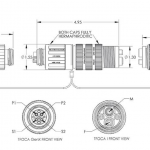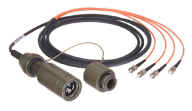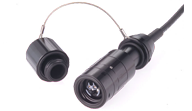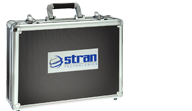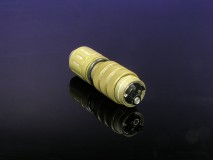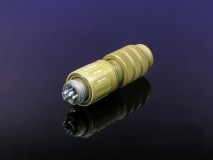TFOCA I – TFOCA GenX™ Fiber Optic Connector Adapter
Overview
Unique in its compact footprint, Stran Technologies’s TFOCA I to TFOCA GenX Connector Adapter is designed to assist in the transition of the legacy TFOCA I tactical interconnect system to Stran Technologies’s next generation TFOCA GenX fiber optic connector. One major advantage of this connector adapter is that it minimizes disruption and/or overhauling of existing fiber optic communication systems currently deployed throughout the world.
Applications
-
Cabinet Mounted Communication Systems
-
Deployable Military Tactical Systems
-
Harsh Environment Video/Data Transmission
-
Outdoor Fiber Optic Connectors
-
Homeland Security and Surveillance
Features / Options
-
First and only in the industry with 100% optically tested stainless steel alignment sleeves (TFOCA I).
-
Field demountable front inserts for improved maintainability. Less than 5½” length without dustcaps
-
Other configurations available, such as: 45° and 90° models and TFOCA GenXTM keying combinations
-
PC polish on the zirconia ferrules (TFOCA GenXTM)
-
Standard hermaphroditic adapter, both TFOCA I and TFOCA GenX connectors can be used as plug or receptacle
-
Standard hermaphroditic, or genderless dustcaps on both adapter ends
-
TFOCA GenXTM connector is fully compliant to the MIL-PRF-83526/16 specification
Specifications
| Title | Description |
|---|---|
| Optical Insertion Loss | TFOCA GenX to TFOCA I @850nm: 4.25 dBmaxTFOCA GenX to TFOCA I @1300nm: 3.40 dBmaxTFOCA I to TFOCA GenX @850 & 1300nm: 2.25 dBmax |
| Vibration | 10 g’s per EIA/TIA-RS-455-11 |
| Mating Durability | 2000 cycles per EIA-455-21 |
| Thermal Shock | -54°C to +71°C per TIA/EIA-455-71 |
| Mechanical Shock | Per EIA/TIA-RS-455-11 Test Condition C |
| Temperature Life | 250 Hours @ +85°C per EIA/TIA-RS-455-4 |
| Corrosion Resistance | Per TIA/EIA-455-16 Test Condition C |
| Humidity | 10 cycles per TIA/EIA-455-5 |
| Fluid Immersion | Per TIA/EIA-455-12 |
| Crush Resistance | 450 lbs per TIA/EIA-455-12 |
| Maintenance Aging | Per MIL-STD-1344, method 2002 |
| Impact | Per TIA/EIA-455-2 |
Drawings
